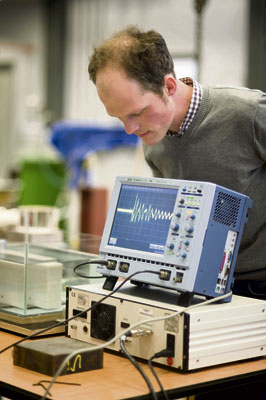There is more information in seismic waves than is generally used, says Dr Karel van Dalen. His new wave processing method could benefit oil and gas explorations.
“It was one of my finest moments,” recalls Karel van Dalen (PhD student at Civil Engineering and Geosciences). “I had calculated the propagation of sound waves through porous stone and had predicted the waveforms at its surface. When I did the experiment some time later in the laboratory of the university in Leuven, the exact same waveforms appeared on the screen.” It confirmed to him that he was on the right track, and that he’d finally mastered the complex mathematics of how sound waves travel along the surface of and through porous material.
The practical applications of such knowledge lie in oil and gas exploration, but also in detecting groundwater or the examining of bones. Typically the damping or propagation speed is measured to assess certain material properties. However, if one not only wants to find out how much gas is contained in the stone (the porosity) but also how mobile it is (the permeability), one must analyse the full waveform instead of just its speed and damping. Once Van Dalen had figured out how sound waves propagate, he could start on the inverse problem: given a particular waveform, what are the material properties causing it? He approached this by calculating the difference between measurement and model, and subsequently minimising the result.
The trouble was: this gave him not a single solution but rather a range of possible values for the gas content and mobility that fit the bill. Repeating the analysis for another type of wave (shear instead of compression), produced another range of solutions. However, the overlap of the two pretty precisely pinned down the values for porosity and permeability.
Until now, most of this work has been lab-based and computer-calculated. But in a bore hole the same technique could be used to map the permeability of the geological surroundings up to distance of 40 metres.
Van Dalen has recently published his findings in Geophysical Research Letters and will soon inform the Dutch Petrophysical Society of his findings.
K.N. van Dalen, ‘Multi-component acoustic characterization of porous media’, 7 March 2011, PhD supervisors Professor Kees Wapenaar, Professor David Smeulders and Dr Guy Drijkoningen.
It’s Spring again! Goodbye to that long-lasting winter of snowstorms, frozen ponds and biting winds. Gone are the days when we hated to leave our warm homes and walk along the lonely snow-covered streets in the fear of slipping and hurting ourselves with every step we took. But now it was suddenly and miraculously a fine spring morning as I made my way to the university. I noticed some lush green bushes planted in a row along the road side. A few days later I saw some small purple flowers sprouting up in between the tram tracks. As the days passed, bright yellow and white flowers started blooming from the roadside plants, which made me stop to take this picture.
I’d like to imagine that everyone who noticed these new beautiful flowers would have become drowned in a world of happiness and at least felt for a fleeting moment: ‘How soon and wonderful are the changes happening around me.’ Although the city is green and beautiful, these plantings by Gemeente Delft are definitely a good idea. A sense of warmth is tapping at the door with these bright sunny days, unpredictable showers, flowers blooming, birds chirping, all heralding the onset of spring. Welcome back spring!



Comments are closed.